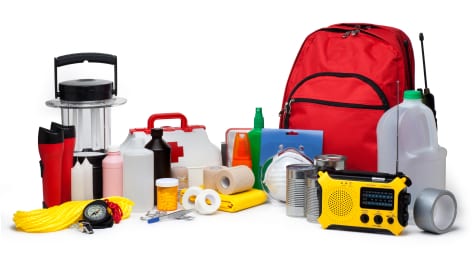Is your family prepared for an emergency?
Making sure you have a safety plan in place can make an enormous difference in the event that a natural disaster hits. In fact, your survival could depend on it. Especially since during a time of disaster, you’re not likely to have time or be in the proper frame of mind to deal with the unexpected.
Here are some ways to make sure you’re prepared:
1. Make sure you’re able to receive warnings and updates, be aware of your area’s street evacuation routes. There are different ways to receive warnings and updates:
- Invest in a portable weather radio. It’s suggested to purchase a NOAA (National Oceanic and Atmospheric Administration) Weather Radio All Hazards (NWR) which consists of a group of radio stations that provide nonstop weather information.
- Sign up for weather alerts. Many are free and can come via text, emails or phone messages.
2. Make sure you have enough supplies stocked in both your home and vehicles.Most experts recommend that you stock up with enough supplies to last for five to seven days. Your car should have enough supplies for two to three days. It’s extremely important to have backpacks, for each person, stocked with the basic necessities. The stocked backpacks can be thrown in the car in addition to any other supplies that can fit if a quick evacuation is necessary.
Here’s a standard list of supplies, but make sure to adjust as necessary for your family’s specific needs:
- Water. One gallon of water per person for each day preparing. This is for drinking and sanitation.
- Non perishable food. This should consist of items such as granola bars, protein bars, and peanut butter. Look for items geared towards athletes as they most often contain sustaining ingredients. Avoid items that are high in sodium but high in protein in carbohydrates. Don’t forget about pet food!!
- Portable generators. If power outages are a common occurrence in your area…for about $300 you can find a good one. You could waist that with the need to replace food after being spoiled from a down refrigerator and/or freezer.
- Tennis shoes and socks. You may be sleeping when a disaster occurs or simply not wearing your shoes. You will want to make sure your feet are protected. Can you imagine walking through broken glass or walking a large distance barefoot?
- Battery or hand cranked radio.
- Flashlight
- Batteries to power your radio, flashlight or any other battery operated items you may need.
- First Aid Kit. Make sure to adapt this to your family’s specific medical needs. Stock extra medical devices and prescriptions.
- Cell phone with extended chargers. You can purchase these chargers at your carrier’s stores or general electronics store.
- Cash and coins
- Baby food and diapers
- Disinfectant – Bleach is a good common disinfectant that can also be used to treat water.
- Feminine supplies such as tampons
- Trash bags
- Toilet paper
- Fire extinguisher
- Something to entertain your children. Calming children in a time of emergency can be a big deal!
- Important paperwork such as insurance cards, car and house titles, copies of each family member’s ID, list of important phone numbers with nearest hospital information, etc.
3. Have a home emergency evacuation plan or in-home safety plan for any type of disaster that could occur where you live. Practice this plan every six months. These plans should include things such as how to get out of the house in case of a fire or how to protect yourself if you’re inside during an earthquake. And of course, make sure that all family members know how to call 9-1-1.
Remember, emergencies strike when you least expect them, so take some time today to make sure your family is prepared for whatever tomorrow could hold.





